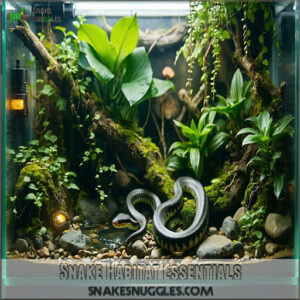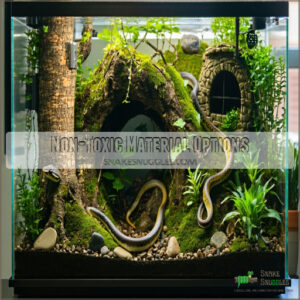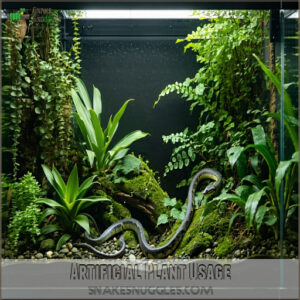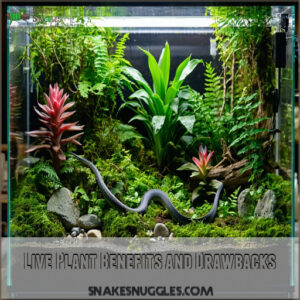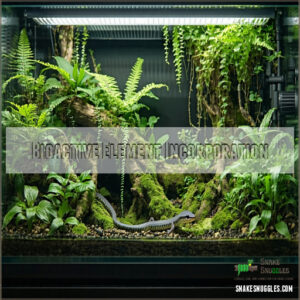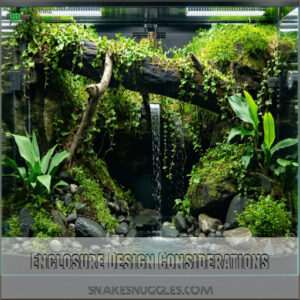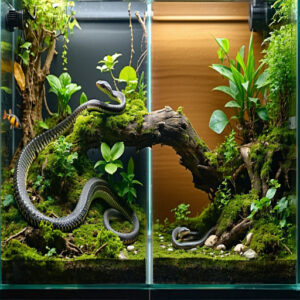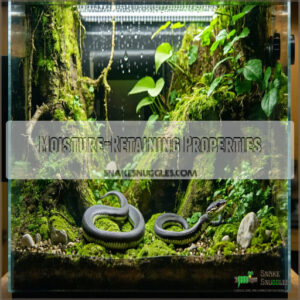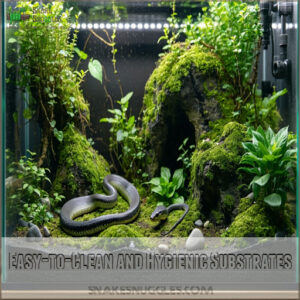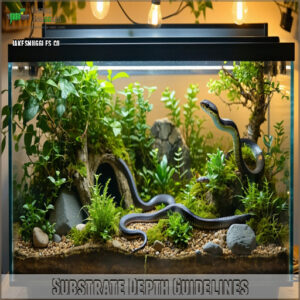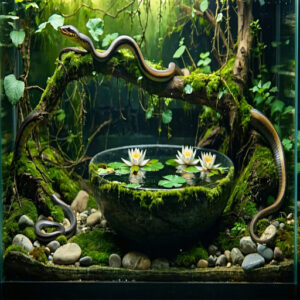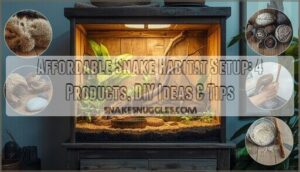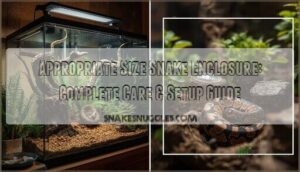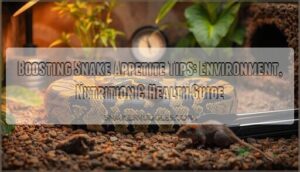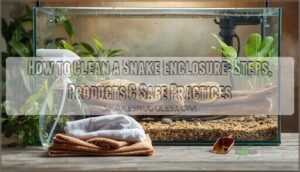This site is supported by our readers. We may earn a commission, at no cost to you, if you purchase through links.
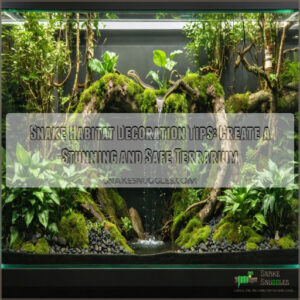 You’ll want to create a snake habitat that’s both stunning and safe.
You’ll want to create a snake habitat that’s both stunning and safe.
Start with a proper heat gradient using thermostats and heat mats – your scaly friend needs temperature control like we need coffee in the morning.
Add cork bark and driftwood for natural climbing spots, and incorporate non-toxic artificial plants for a jungle vibe.
Don’t forget proper ventilation through mesh panels, and maintain humidity with strategic water features.
Think of your terrarium as a five-star resort where every decoration serves a purpose. The art of mixing safety with style transforms basic enclosures into remarkable reptilian retreats.
Table Of Contents
- Key Takeaways
- Snake Habitat Essentials
- Decorative Element Selection
- Enclosure Design Considerations
- Substrate Options and Maintenance
- Water Features and Enrichment
- Frequently Asked Questions (FAQs)
- How should I decorate a snake’s habitat?
- Should you decorate your corn snake’s enclosure?
- How do you decorate a snake terrarium?
- How do you care for a snake’s enclosure?
- How to decorate a vivarium for a snake?
- How do you choose a snake enclosure?
- How to decorate a snake terrarium?
- What should my snake enclosure look like?
- What do snakes like in their enclosures?
- What should I put in my snakes enclosure?
- Conclusion
Key Takeaways
- You’ll need to establish proper temperature control with heat mats and thermostats, creating a gradient that lets your snake move between warm and cool zones for optimal comfort.
- You should mix natural and artificial elements like cork bark, driftwood, and non-toxic plants to create climbing spots and hiding areas, ensuring each decoration serves both aesthetic and functional purposes.
- You’ll want to maintain proper ventilation through mesh panels and control humidity with strategically placed water features, while choosing substrates that support moisture retention and easy cleaning.
- You must secure all decorative elements firmly in place, ensuring branches and rocks are properly anchored and weighted to prevent accidents, while leaving enough open space for your snake to move freely.
Snake Habitat Essentials
Creating the perfect snake habitat starts with meeting essential needs like temperature, humidity, and ventilation. These basics guarantee your snake stays healthy, comfortable, and stress-free in its enclosure.
Naturalistic Environment Creation
Creating naturalistic environments in your snake terrarium setup promotes comfort and health.
Use eco-friendly decor like cork bark, driftwood, and stones to mimic a natural habitat. Add varied habitat textures for visual stimulation and environmental balance.
Incorporate natural lighting to enhance the reptile habitat design. These habitat decoration tips promote a realistic snake terrarium setup, supporting natural behaviors and well-being.
For a safe and thriving environment, consider using snake tank supplies to create a stimulating space.
Temperature Regulation Methods
To keep your snake cozy, use heat sources like heat mats or lamps paired with thermostats for precise temperature control.
A proper heat gradient setup ensures thermal regulation, letting your snake move between warm and cool zones.
Install heat lamps securely and monitor thermal gradients regularly.
This balance mimics nature, promoting health and comfort in their terrarium, which is part of maintaining ideal snake habitat essentials, such as temperature control systems, is essential for creating a healthy environment with proper thermal regulation.
Humidity Control Techniques
Aiming for ideal humidity levels? Use water bowls for evaporation, misting systems, or foggers to boost moisture.
Humid hides create cozy, damp retreats. Hygrometers help you monitor humidity gradients, ensuring consistency.
Want extra flair? Add water features that double as décor. Remember, balance is key—too much humidity invites mold, too little stresses your snake, and maintaining the right humidity levels is crucial.
Ventilation Requirements
Humidity’s under control, but what about air flow?
Proper ventilation keeps oxygen levels steady and air quality healthy.
Use breathable materials like mesh panels or vents to prevent stagnant air.
Aquarium ventilation systems can help, too.
- Mesh lids allow fresh air while keeping escape artists contained.
- Side vents improve circulation.
- Avoid sealing the enclosure entirely—it’s not a submarine!
Decorative Element Selection
Choosing the right decorative elements for your snake’s terrarium is about more than looks—it’s about safety and functionality.
Focus on non-toxic materials, plant options, and features that mimic natural habitats to create an engaging and healthy environment.
Non-Toxic Material Options
When choosing decor, stick to nontoxic materials like cork bark, safe woods, and natural stone.
Ceramic hides are excellent for secure hiding spots, while eco-friendly options ensure your snake’s health.
Always verify items are reptile-safe and toxin-free. Avoid sharp edges or treated wood.
Non-toxic decor items look great as well as create a safe, natural environment. Reptile owners should consider non toxic hides for a healthy habitat.
Artificial Plant Usage
Artificial greens are perfect for creating stunning, low-maintenance terrariums that snakes will love. With fake foliage, you can craft beautiful plant arrangements that stay pristine without the upkeep of live plants.
- Use artificial foliage for realistic texture and depth.
- Experiment with decor placement to mimic natural spaces.
- Line terrarium backgrounds with lush reptile plant choices.
- Avoid sharp edges for snake safety.
Creating a snake terrarium requires understanding of temperature regulation techniques to guarantee a healthy environment. With proper planning, you can create a beautiful and low-maintenance space for your snakes.
Live Plant Benefits and Drawbacks
Live plants enhance your terrarium’s natural habitat with oxygen boost, humidity control, and stress-reducing hiding spots.
Bromeliads, spider plants, and ferns are excellent reptile-safe plant choices.
However, they come with Toxicity Risks if ingested, higher Maintenance Costs, and mold issues.
Reptile plant choices like ferns or Fittonia thrive well, but smart Plant Placement prevents damage.
Careful Live Plant Selection guarantees safe habitat decoration while avoiding unnecessary headaches.
Plant Care Tips are essential!
Bioactive Element Incorporation
While live plants add beauty, bioactive elements create a functioning ecosystem that mimics a natural habitat.
These setups use:
- Reptile substrate options to support soil quality.
- Micro fauna to manage waste.
- Fungal growth and bacterial balance to aid decomposition.
- Smart habitat temperature control to sustain life.
Bioactive terrariums reduce maintenance and keep your snake’s environment thriving.
Enclosure Design Considerations
You’ll need to carefully plan your snake’s terrarium layout to make sure every decorative element is securely anchored and properly weighted for your reptilian friend’s safety.
Your enclosure’s design should match your snake’s size and natural behaviors, with stable climbing structures and hiding spots that won’t tip over during exploration, ensuring a safe environment for your reptilian friend.
Secure Placement of Decor
Now that you’ve selected your decor, let’s make sure it stays put! Proper secure placement of snake enclosure decoration assures accidents and assures your scaly friend’s safety.
Anchor branches firmly using zip ties or aquarium-safe silicone. Position hides on level surfaces to prevent tipping.
When installing climbing structures, test their stability by giving them a gentle shake. Your snake will thank you for the thoughtful setup, ensuring a safe and happy environment with proper care.
Weight Limit and Rock Stability
When selecting rocks for your snake’s habitat, prioritize weight distribution and stability to prevent accidents.
Large rocks must support your snake’s full weight during climbing and basking activities. Choose smooth-surfaced rocks that maintain safe temperatures under heating elements.
Distribute decorative elements evenly throughout the terrarium, and make sure multiple contact points with the substrate for best stability.
Check rock placement regularly to maintain a secure environment.
Sturdy Anchor Points for Branches
Proper branch support transforms your snake’s terrarium into a secure climbing paradise.
You’ll need to create stable fixtures using anchor materials like silicone adhesive or mounting brackets.
When installing climbing structures, verify each anchor point can support three times your snake’s weight, and secure each branch at multiple points.
Test stability by gently pushing from different angles before introducing your pet.
Matching Decor to Terrarium Size
Smart space optimization in your snake enclosure starts with scaling decorations to match your terrarium’s dimensions.
Proper terrarium size is paramount for snake health, so research optimal terrarium dimensions.
You’ll want to maintain visual balance while ensuring your reptile has plenty of room to move.
Consider your snake’s adult size when planning your terrarium layout.
To achieve this balance, follow these guidelines:
- Use the rule of thirds: divide your space into sections for basking, hiding, and exploring
- Choose decor that takes up no more than 30% of available floor space
- Scale branches and hides to 1.5x your snake’s body width
- Leave clear pathways equal to your snake’s fully stretched length
- Position larger pieces against walls to maximize open space in the center, ensuring your snake has enough room to move freely and thrive in its environment.
Substrate Options and Maintenance
You’ll find that choosing the right substrate for your snake’s habitat goes beyond just picking what looks good, as different materials like coconut husk, cypress mulch, or reptile carpet each serve specific functions for moisture control and cleaning ease.
Your substrate choice and maintenance routine will directly impact your snake’s health, comfort, and overall well-being in its terrarium environment.
Natural Vs. Synthetic Substrate
Your choice of substrate forms the foundation of your snake’s home, with both natural and synthetic options offering unique benefits.
Natural substrates like coconut husk and cypress mulch create an eco-friendly environment that mimics your snake’s natural habitat, while synthetic materials such as reptile carpet provide easier maintenance.
Consider your snake’s preferences and specific needs when choosing between pest-free substrate options that support proper humidity control and material safety.
Moisture-Retaining Properties
Several moisture-retaining substrates work like natural sponges in your snake’s habitat, maintaining ideal humidity levels.
Coconut fiber and sphagnum moss excel at water retention, gradually releasing moisture to create consistent humidity control.
Mix these substrates strategically to develop hydration management zones, allowing your snake to choose its preferred moisture levels.
For enhanced humidity control, consider layering different substrate options beneath your snake’s favorite hiding spots to achieve consistent humidity control.
Easy-to-Clean and Hygienic Substrates
Inside your reptile enclosure, hygienic materials like reptile carpet offer a practical foundation for your snake tank decor.
You’ll find cleaning routines become remarkably simple with safe flooring options that prioritize maintenance. Paper towels provide excellent spot-cleaning convenience, while specialized substrates feature antimicrobial properties to maintain hygiene.
Consider layering different materials to combine easy cleaning with aesthetic appeal, ensuring your snake’s home stays pristine. Proper substrate depth management is integral for maintaining a healthy environment and supporting your snake’s natural behaviors.
Substrate Depth Guidelines
Now that you’ve got your substrate picked out, let’s get the depth just right for your scaly friend.
The perfect substrate layers on your snake’s size and habits.
- Small snakes (under 3 feet): Maintain 1-2 inches of substrate depth for proper moisture levels
- Medium snakes (3-6 feet): Use 2-3 inches to support burrowing needs
- Large snakes (over 6 feet): Keep 3-4 inches for ideal habitat decoration
Remember to check substrate depth weekly during habitat maintenance – it’s your snake’s foundation for comfort!
Water Features and Enrichment
You’ll discover how water features and enrichment elements create an engaging environment that keeps your snake active and healthy.
By incorporating the right water bowl size and strategic placement of climbing structures, you’ll provide essential hydration while encouraging natural behaviors your snake would display in the wild, which includes essential hydration.
Selecting Appropriate Water Bowls
You’ll need to set up the right water bowl station for your snake’s hydration needs.
Consider these essential factors when selecting and placing water features in your terrarium: A wide variety of snake water bowls are available online.
| Feature | Recommendation | Safety Tip | Best Practice |
|---|---|---|---|
| Bowl Size | 1.5x snake width | Non-tippable base | Replace daily |
| Material | Ceramic/glass | Smooth edges | Dishwasher safe |
| Depth | 1-2 inches | Shallow sides | Clean regularly |
| Placement | Cool side | Away from substrate | Easy access |
Choose bowls that are sturdy, easy to clean, and appropriately sized for your snake to fully submerge when needed, with a focus on easy access and regular cleaning to ensure the snake’s health and safety.
Humidity Management Techniques
Regular misting keeps your snake’s habitat at ideal humidity levels.
You’ll want to place multiple water bowls near heat sources for natural evaporation, while mixing sphagnum moss into the substrate creates moisture-retention zones.
Automated mist systems and fog machines offer hands-free solutions, but don’t overlook the simple effectiveness of humid hides filled with damp moss for targeted moisture control, using natural evaporation.
Incorporating Hides and Climbing Structures
Your snake will thrive with strategic hide boxes and climbing structures throughout the terrarium.
Create multiple snake hiding places using cork bark tubes, rock formations, and reptile caves at both warm and cool ends.
Add sturdy branch supports and climbing walls to encourage natural behaviors, allowing your snake to utilize climbing structures effectively.
You’ll know you’ve done well when your scaly friend actively explores their carefully crafted cave systems and hiding spots.
Providing Temperature Gradients and Enrichment
Building on your hide and climbing setup, let’s create perfect thermal gradients for your scaly friend.
You’ll want to establish temperature zones ranging from 75-85°F using strategically placed heat sources.
Environmental enrichment keeps your snake mentally stimulated and physically active.
- Install a heat lamp on one side to create a basking spot
- Add cork bark pieces at varying heights for thermal regulation
- Place climbing structures near heat sources for thermoregulation options
- Create cool retreats using ceramic hides in the opposite corner
Rotate enrichment elements monthly to maintain interest and encourage exploration.
Frequently Asked Questions (FAQs)
How should I decorate a snake’s habitat?
Create a cozy habitat with natural decor like cork bark and branches for climbing.
You’ll want hiding spots, artificial plants, and sturdy rocks.
Don’t forget non-toxic materials and secure placement for safety.
Should you decorate your corn snake’s enclosure?
Yes, you’ll definitely want to decorate your corn snake’s home with branches, trailing plants, and secure hiding spots.
It’s essential for their mental well-being and helps them feel safe in their environment.
How do you decorate a snake terrarium?
Research shows 78% of snakes thrive with enriched habitats.
You’ll want to add climbing branches, secure hides, and safe substrate like coconut fiber.
Mix artificial plants and natural cork bark for an ideal environment.
How do you care for a snake’s enclosure?
Clean your snake’s enclosure daily by removing waste and changing water.
Check temperature and humidity levels, spot-clean substrate weekly, and do a deep clean monthly with safe disinfectants.
Don’t forget regular vet checkups to ensure your snake’s health, and remember to use safe disinfectants during the cleaning process.
How to decorate a vivarium for a snake?
Like building a cozy home, you’ll want to include branches for climbing, multiple hiding spots, and sturdy rocks.
Add artificial plants, cork bark, and natural substrates to create a comfortable, enriching environment.
How do you choose a snake enclosure?
Select an enclosure that’s one-third your snake’s length and width, with secure latches and proper ventilation. You’ll want escape-proof features, temperature controls, and enough space for natural behaviors and growth.
How to decorate a snake terrarium?
Ready to bring your snake’s home to life?
Install safe climbing branches, add multiple hides, incorporate artificial plants, and create temperature zones.
You’ll want substrate depth of 1-4 inches for burrowing enrichment.
What should my snake enclosure look like?
Your snake’s home needs hiding spots, climbing branches, and secure substrate.
Add temperature zones with basking areas, proper humidity controls, and enough space for movement.
Don’t forget a water bowl for soaking.
What do snakes like in their enclosures?
Just as bears need cozy caves, your snake needs secure hiding spots.
You’ll want to include water bowls, temperature zones, and natural-looking décor that creates a stimulating environment.
What should I put in my snakes enclosure?
You’ll need a secure hide box, climbing branches, water bowl, substrate like coconut fiber, and temperature-regulating elements. Don’t forget enrichment items like artificial plants and cork bark for exploration.
Conclusion
Creating a dreamy snake habitat that rivals a five-star resort isn’t rocket science.
By following these snake habitat decoration tips, you’ll craft a terrarium that’s both visually stunning and perfectly suited to your serpent’s needs.
Remember to prioritize safety with proper temperature gradients, ventilation, and secure decorations.
Mix natural elements with artificial ones, maintain appropriate humidity levels, and regularly check all components.
Your snake will thrive in its custom-designed paradise while you enjoy its beauty.
- https://animals.mom.com/homemade-decorations-snake-cage-6815.html
- https://www.reddit.com/r/snakes/comments/117pb5y/what_are_your_favorite_cheapdiy_decorclutter_for/
- https://www.zenhabitats.com/blogs/reptile-care-sheets-resources/easy-diy-reptile-enclosure-enrichment-for-snakes
- https://talis-us.com/blogs/news/diy-snake-tank-decor-tips-and-ideas
- https://www.amazon.com/snake-decorations-terrarium/s?k=snake+decorations+for+terrarium

